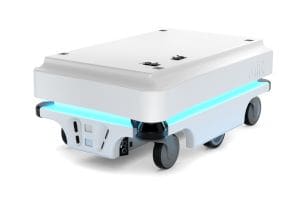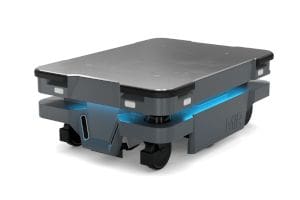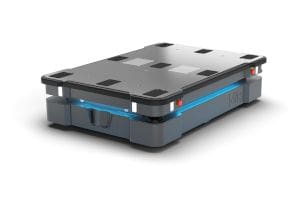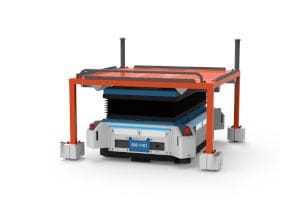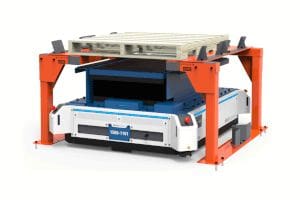Production Line Feeding and Workcell Delivery
Autonomous mobile robots, also known as AMRs, are becoming more and more popular in production facilities for frequently recurring tasks such as production line feeding. In the modern manufacturing plant, production line feeding (also known as workcell delivery) is the process of supplying component parts and raw materials from the warehouse to production assembly line to ensure that there are sufficient supplies to keep production flowing. AMRs are ideal for the automation of this internal logistics task because they are able to navigate through the facility and deliver the necessary materials quickly and efficiently with minimal human worker direct involvement.
The Challenges of Using Human Workers for Critical Replenishment Tasks
Traditionally, material handlers have performed the line replenishment task. However, there are several challenges and disadvantages to this approach:
-
- For all their flexibility and ingenuity, a human worker is expensive… and in this age of inflation, the cost of wages and benefits is rapidly rising. This puts a sizable cost on the labor needed to support line delivery and other material handling operations.
-
- Industry is also experiencing an overall labor shortage. It is harder to attract talent for material handling roles, even at the higher wages currently in effect. This means that a company may have trouble finding sufficient employees to staff the replenishment operation.
-
- Even when a human worker is hired, a company’s problems aren’t solved. There is a serious labor retention challenge in this era when workers frequently jump from one employer to another. In practice, this means that a company is continually seeking to replace leaving workers, and spending time and resources training the new employees… all to repeat the cycle within weeks when the new employees leave.
-
- Further, human workers are often not able to work as quickly or efficiently as AMRs, which can slow down the manufacturing process.
-
- Finally, human workers are prone to errors, such as delivering the wrong materials to a workcell. This can cause production delays and the need for rework, which can be costly for the company.
Avoiding Production Shutdowns: Why Production Lines Can’t Run Out of Parts and Materials
Running out of parts and materials will cause a production line to cease operation. When a workcell runs out of materials, manufacturing must stop until more materials can be delivered. This can cause delays and lost productivity, which can be costly for the company. Beyond the cost of the idle labor, lost production time has a very real opportunity cost of the value of goods which will not be created.
Lost production time can lead to missed shipment, expedited shipping costs, dissatisfied customers, and in the worst case, lost customers. For these reasons, avoiding shutdowns is critical for an efficient enterprise.
Why Autonomous Mobile Robots are Ideal for Production Line Feeding
There are many reasons why an autonomous robot is ideal for production line feeding:
-
- AMRs can work around the clock, without breaks or the need for rest, ensuring that workcells are always supplied with the necessary materials so that production can continue without interruption.
-
- This means autonomous robots can be available for tasks at times when human workers might be unavailable. AMRs are also highly scalable, meaning that trainig time for new robots consists of copying the parameters of the existing fleet. More AMRs can be added when required, and AMRs can even be dialed back if less is required.
-
- A mobile industrial robot can reduce errors, since robots will not make mistakes. As long as the correct parts are provided, and the right destination is specified, the robot will get it there.
-
- AMRs also free up the company’s staff for more complex, higher value tasks. No need to tie up the team shuttling items back and forth… the AMRs can handle those repetitive tasks so that workers can focus on more important jobs.
Autonomous Mobile Robots (AMRs) are increasingly being used in best-in-class production facilities for a number of different supply chain tasks, including production line feeding (workcell delivery). AMRs are ideal for this task because they are able to navigate through the facility and deliver the necessary pallet, case or totes quickly and efficiently. They can work around the clock, without breaks or the need for rest and can be programmed to perform specific tasks. Using human workers to replenish workcells can present some challenges such as, slow process and errors. Running out of parts and materials can also be a problem for production lines which can cause delays and lost productivity. Automated workcell delivery using AMRs can help to increase productivity, reduce the risk of errors and rework, and improve inventory management.
It’s worth noting that autonomous mobile robots (AMRs) differ significantly from automated guided vehicles (AGVs) in capabilities. The AMR is equipped with artificial intelligence and machine vision, which enable it to operate autonomously, even when surrounded by people and moving objects. The AGV, on the other hand, operates on a defined path and is unable to perform the decision-making of an AMR when encountering an obstacle. AMRs provide much more flexible automation, and are more versatile for the purpose of industrial automation.
The Importance of Selecting an Experienced AMR Consultant
When implementing AMRs in production facilities, it is important to work with an experienced warehouse automation consultant such as CSSI Technologies. Consultants can assess the specific needs of the facility and determine the best AMRs and systems to use. They can also assist with the implementation of the AMRs, including programming and integration into the company’s existing systems. They can also help with the training of employees who will be working with the AMRs and provide ongoing support and maintenance. CSSI provides services such as these to ensure that robotics is properly integrated in a customer’s operations.
Contact CSSI to Discuss Production Line Feeding with Mobile Robots
Take the first step towards improved efficiency by contacting CSSI to discuss using autonomous mobile robot technology to feed your production lines and workcells. Or complete the form below to begin your automation journey!

